Lenovo Yoga 3 Pro Review: Refreshed With Faster Core M
by Brett Howse on March 13, 2015 8:00 AM ESTSystem Performance
For the new model, Lenovo has taken the step of moving from the 15 watt Haswell-U series processors to the 4.5 watt Broadwell-Y based Core M. Their first run of Yoga 3 Pros came with the Core M-5Y70, which has a base frequency of 1.1 GHz, and a boost of 2.6 GHz. Lenovo has refreshed the Yoga 3 Pro to include the 5Y71 processor, which increases the base clock to 1.2 GHz and boost to 2.9 GHz. It will be interesting to see the performance delta between the Yoga 3 Pro and the Yoga 2 Pro.
The Broadwell-Y processors have two cores and hyperthreading. With a thermal envelope of just 4.5 watts though, boost clocks with heavily multithreaded workloads will be reduced as compared to the U series processors. During a multi-threaded run of Cinebench R15, the Core M processor would hover between 1700 and 1800 MHz, but the Core i5-5200U would do the same workload at 2400 MHz and not deviate at all. On single-threaded workloads, the Core M has more headroom to allow the one core to clock higher, and on a single-threaded run of Cinebench R15 it would clock as high as 2600 MHz. However there was a lot of variance during the run, and the Core M-5Y71 would fall as low as 1200 Mhz, with the majority of the time spent between 2000 Mhz and 2200 Mhz. Broadwell-U on the other hand would stay exactly at 2400 Mhz again during the same workload, with very little change in frequency during the run. As compared to Broadwell-U with a 15 watt TPD, the Broadwell-Y limits clock speed quite a bit more. Let’s go through some benchmarks to see how much this affects the Yoga 3 Pro, and especially if the IPC improvements with Broadwell can make up for the lower TDP.
For our benchmarks, I have selected a sample of similar devices in which to compare against. I have also included the Dell XPS 15, which has a quad-core CPU, GT750 GPU, and 91 Wh battery to bracket these scores on the high end. To compare against the low end, I have included the HP Stream 11, which has the Atom N2840 processor. It is interesting to note that the Atom (rebranded as Celeron) has a slightly higher TDP (7.5 watts vs 4.5 watts of the Core M) and it will be a good comparison to see how much more performance Core has than Atom. To compare the Yoga 3 Pro against any other devices, please check out our Notebook Bench.

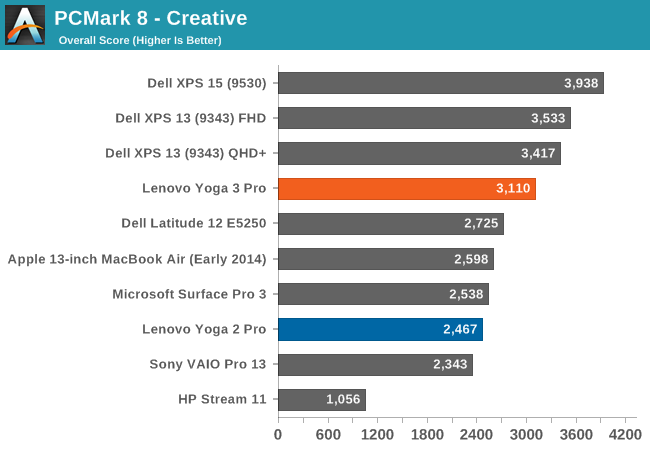
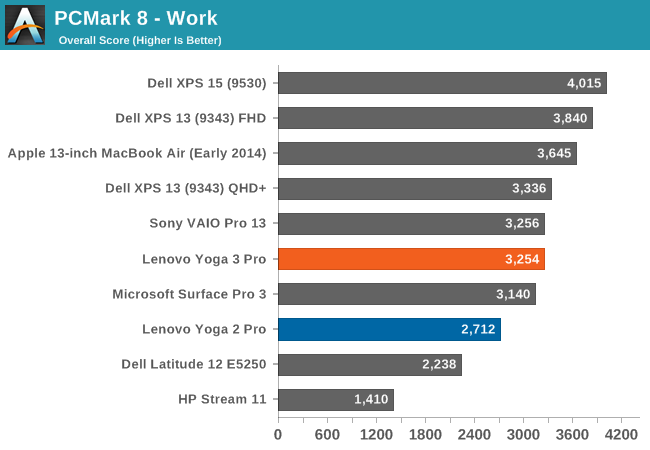
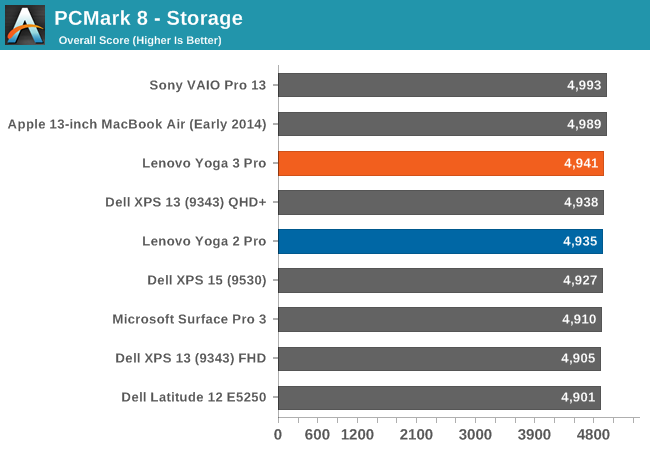
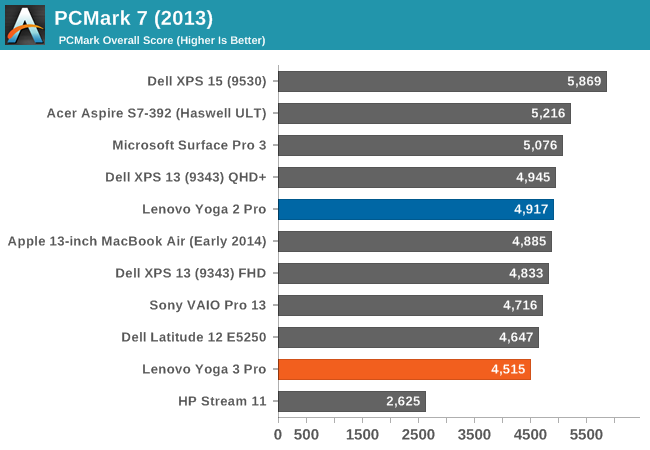
PCMark 8 has four workloads which are Home, Creative, Work, and Storage. Each has a different set of workloads which Futuremark believes represent a good sampling of tasks for each category. Here the Yoga 3 Pro does very well, with scores that are more often than not well above the Yoga 2 Pro’s Core i5-4200U. The Broadwell Core i5s in the XPS 13 still pull a good lead here. The 7.5 watt Bay Trail-M in the HP Stream is sorely outclassed by the 4.5 watt Core M.



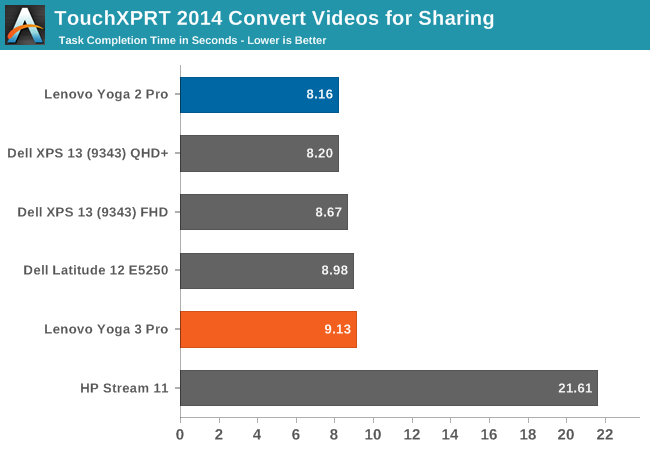
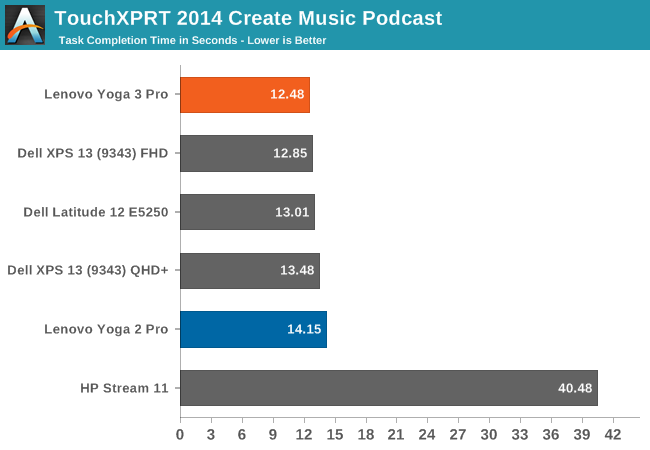

Our next benchmark is TouchXPRT 2014, which is a Windows Store app. It performs several common tasks for a typical home user, and converts the time taken for each task into an overall score. Once again, the 4.5 watt Core M compares very favorably to the 15 watt Yoga 2 Pro processor. In almost all of the tests, Core M is ahead of the Haswell Core i5-4200U of the Yoga 2 Pro. In order to achieve these scores, the GPU driver was updated to the latest version on the Intel site which fixes a problem with the Video Conversion score. We had the same issue with the XPS 13, so if you are the owner of a Broadwell laptop, you may want to update your drivers. The Atom core once again is decimated by Core M.
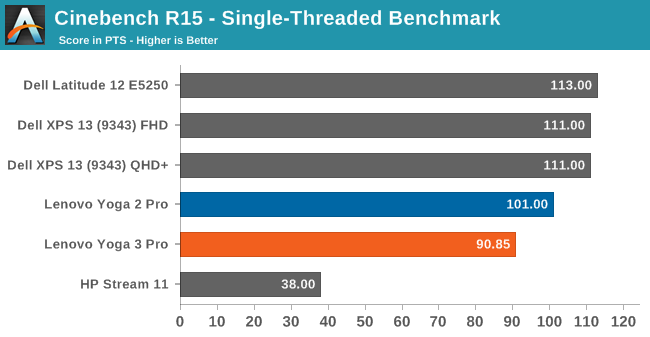

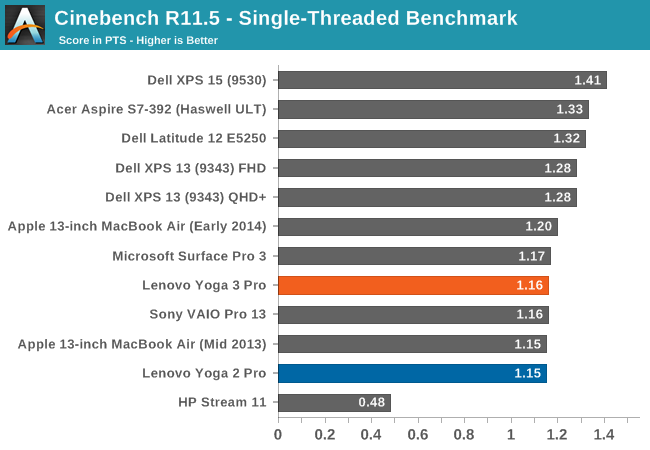
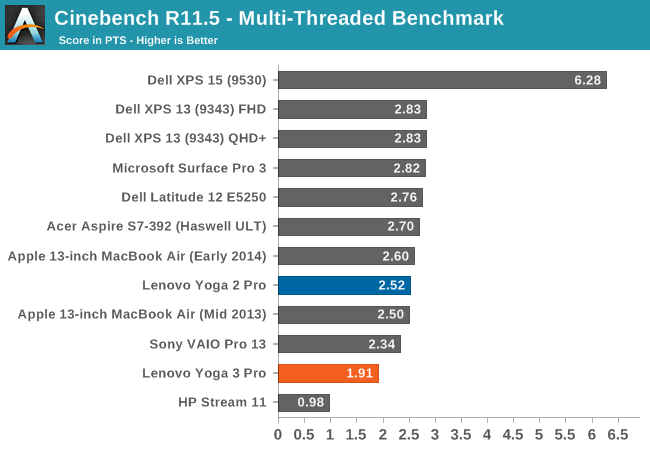


Cinebench is a good long benchmark which shows us how the CPU will perform when maxed out for the duration of the benchmark. Here we can see where Core M starts to falter. On long sustained workloads, it has to cut the CPU frequency to keep within its thermal envelope, whereas the Broadwell-U and Haswell-U CPUs can keep the clocks a lot higher. While running the multithreaded R15, the Core M would hover around 1800-1900 MHz with all cores in use, and the Broadwell-U would lock in at 2400 MHz and stay there for the duration. x264 is similar, and is a very long benchmark. The higher power envelope of the U series processors allow for more work to be done. You can see the quad-core Dell XPS 15 really pulls ahead on these benchmarks, and the HP Stream continues to fall well behind.
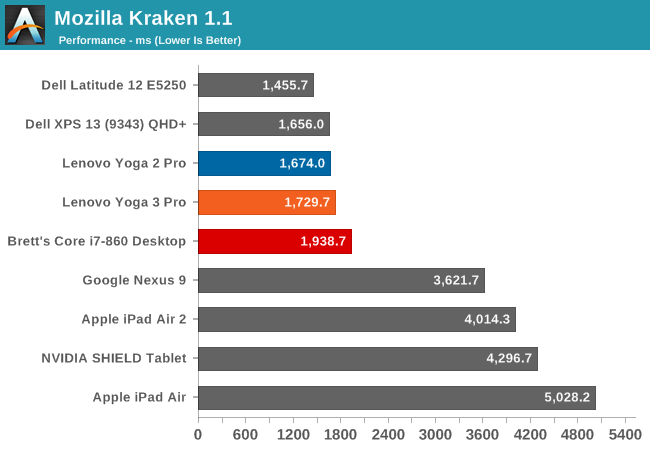

Once again, in web use, the Core M processor is very similar to the outgoing Haswell U based Yoga 2 Pro. Just to put the numbers in a bit more context, I also ran the benchmarks on my Core i7-860 based Desktop (running Chrome, as were the Yogas) and it is pretty clear just how far we have come. The i7-860 is a four core, eight thread 45 nm processor with a 2.8 GHz base clock and 3.46 GHz boost, all in a 95 watt TDP. It was launched in late 2009. Five years later, we have higher performance in a 4.5 watt TDP for many tasks. It really is staggering.
There seems to be a general concensus that Core M equates slow, but clearly this is not the case. For some sustained workloads, yes, the 4.5 watt TDP limits how much performance you are going to get from the CPU, but for many tasks, especially short burst loads, the performance of the 5Y71 is very competitive, often outperforming the Haswell Core i5-4200U from last year’s Yoga 2 Pro. This says a tremendous amount about the Intel 14 nm process, because the IPC improvements of Broadwell vs Haswell are fairly limited. Clearly the CPU has quite a bit of headroom on the 14 nm process to keep the clock speeds up.










113 Comments
View All Comments
Zizy - Friday, March 13, 2015 - link
Core M seems to be a mixed bag. Great if you want short bursts of activity but fails when you demand any longer activity, especially a GPU one. Fine for netbooks, but spending 1k+ to get a tablet class of performance seems pointless to me.XPS 13 has better performance and normalized battery life. What is wrong with Yoga?
Will you also make an in-depth CPU test?
Drumsticks - Friday, March 13, 2015 - link
The performance of the core M 5Y71 parts is leavig me feeling a little bit better for a potential core m SP4. Still, this was with a fan - fanless performance is sure to be worse, and if you have a fan you might as well use the full voltage part!But in any case, I really hope that Windows 10 and Core M skylake can coincide. A skylake Surface Pro 4 in a fanless design could seriously be amazing without sacrificing performance compared to Haswell-U.
mkozakewich - Saturday, March 14, 2015 - link
The funny thing is that it's pretty much always about the cooling. A 5W TDP part works in a 5W TDP case, but it would be helpful to know what the maximum TDP is for turbo workloads. If the SP4 still has a fan and it could push 15 W out, you'd probably get the full performance without throttling.lilmoe - Friday, March 13, 2015 - link
I've never really understood Core M and its value proposition. Maybe current applications aren't optimal. Since ^this ultrabook has a fan, I just can't seem to understand why they didn't wait it out a bit and went with a cheaper Broadwell U that races to sleep much faster. In that aspect, Dell got it right with their XPS 13. No one talks about how thin this device is, especially that it's thinner than Apple's new MacBook. I can't even justify the price to performance ratio even for a fanless Windows x86 tablet. Microsoft should stick with Broadwell U for the SP4 to maintain a performance upgrade at the least.I don't know, Core M probably only has value for those who want an expensive, fanless machine, and this only works for Apple most of the time.
name99 - Friday, March 13, 2015 - link
How do you get that it's thinner than new Macbook?MacBook tapers from 13.2mm to 3.6mm. This is a flat 1.28mm. On "average" MacBook is thinner, and visually it looks far thinner.
lilmoe - Friday, March 13, 2015 - link
Since that seems the only thing you got out of my post, I'm sorry to have offended you...N000RM - Friday, March 13, 2015 - link
Would you say a two penny nail is thin because it tapers to a point? The Yoga is thinner and lighter, fanboi.michael2k - Friday, March 13, 2015 - link
The Yoga is over half a pound heavier. You also fail to understand how triangles work. The Yoga is 1.28cm more or less across the whole laptop. The MacBook is 0.35 to 1.31cm. If we assume the delta is defined by a triangle then it will be 0.48 in average height if they could flatten it's volume, or a total height of 0.83cm, again, if they could squeeze the whole design into a rectangle. And if Apple updates the MacBook Pro, next year, with similar technology it will likely be a straight 1.31cm across.wolfemane - Monday, March 16, 2015 - link
There is a sign on the door that says to leave all Jr. Math Awards with the attendant before entering Anandtech. Obviously you didn't see that... hmmmm... what to do, what to do.heron_kusanagi - Monday, March 16, 2015 - link
I don't know, performance is one thing, but if all you are doing is Office work, maybe some web surfing and casual games, Core M's proposition is ideal.The Asus UX305 (which I hope Anandtech reviews next) is using the Core M, and for the most part, it works as a ultrabook with no added sound profile to it. And its pretty cheap too.